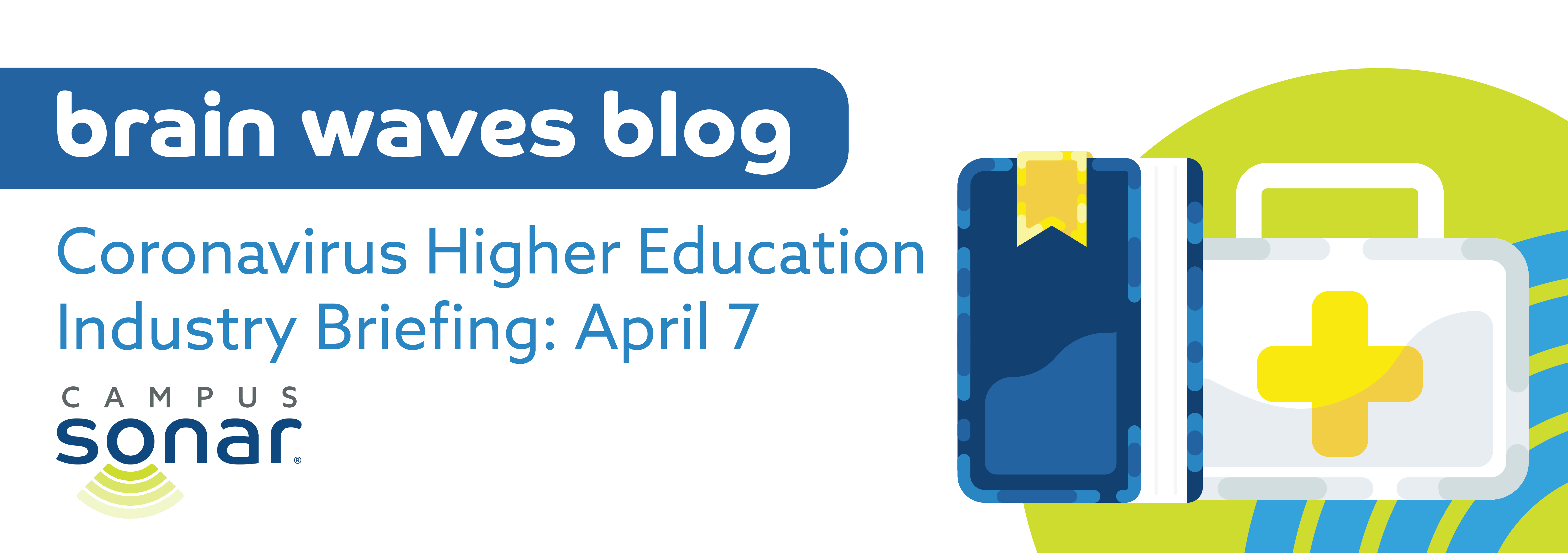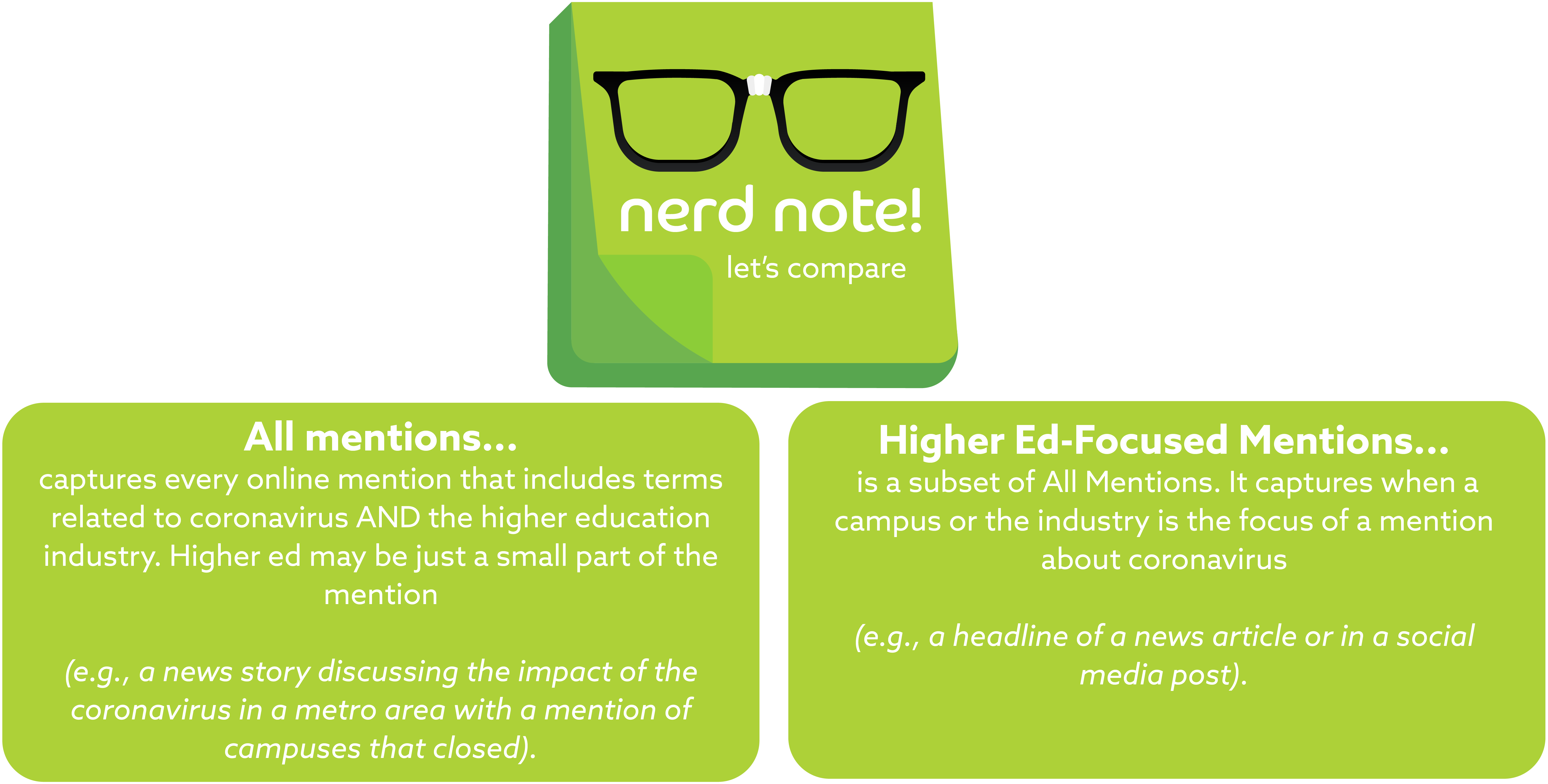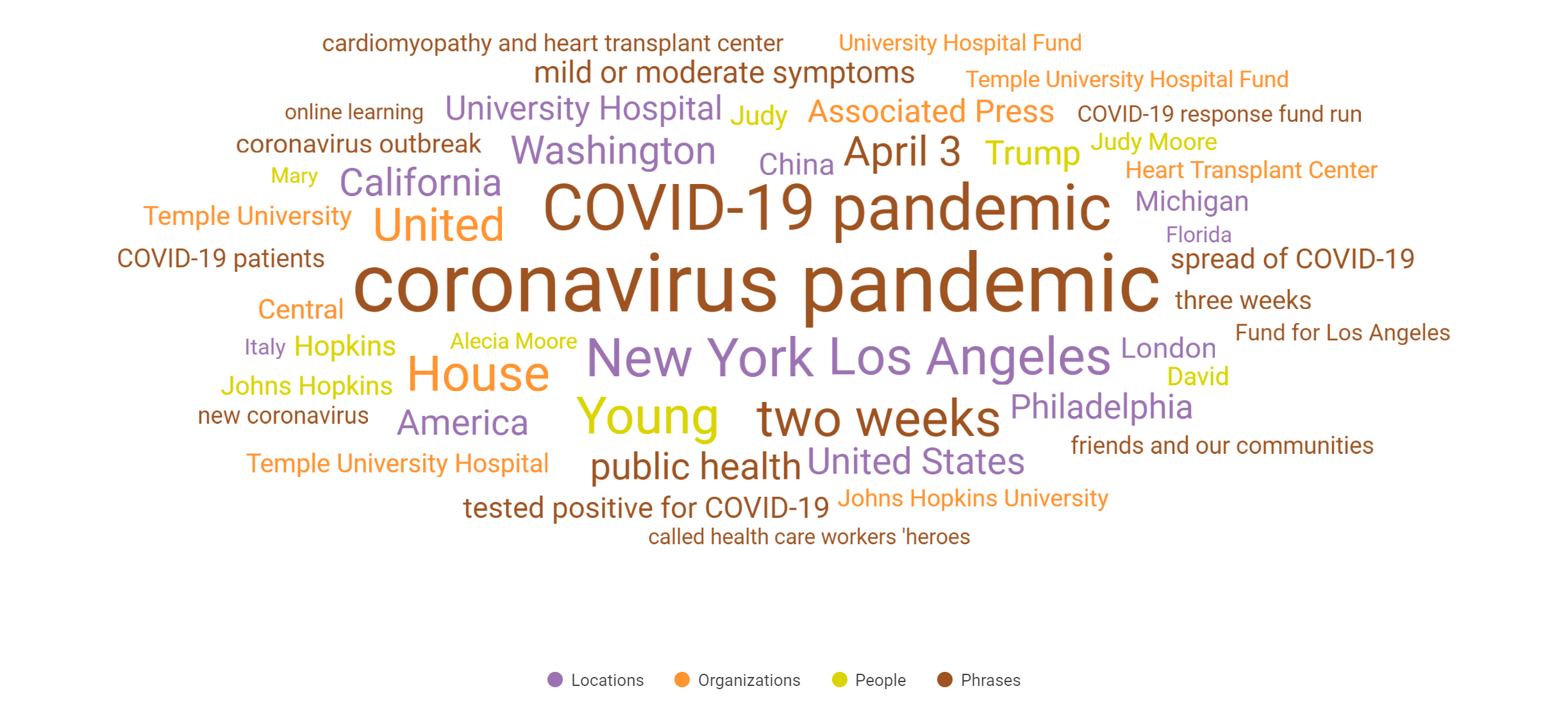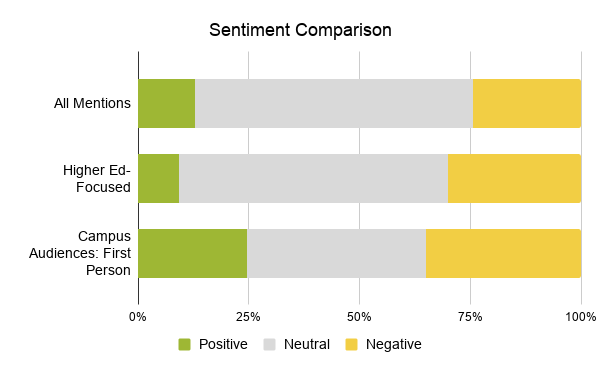Coronavirus Higher Education Industry Briefing: April 7

Students Discuss Cheating
Today’s Briefing analyzes publicly available online conversation in the U.S. and on Reddit and YouTube (which span beyond the U.S.) about the coronavirus and higher education from April 3–6. In this analysis of volume, topics, sentiment, and key audiences, we highlight how campuses frequently mentioned in the news are portrayed, stories of students’ family members and the disease, concerns from medical students, and discussions of cheating.
If you’d like to receive each Briefing in your inbox as soon as we publish it, sign up at info.campussonar.com/covid19. You can also review all prior Briefings. Because of the changing nature of social media data and our understanding of the conversation, each briefing covers a distinct point in time. Comparisons from briefing to briefing may be helpful, but we can’t draw correlations like we could if we were using other datasets such as surveys or historical social media data.
Volume Declined Again
We identified about 318,000 mentions of the coronavirus and higher education April 3–6, ranging from 53,000–114,000 mentions per day. This is about 17 percent fewer mentions than the same period one week earlier. 31 percent of these mentions were higher ed-focused. Remember, our industry-level analysis only captures general higher education mentions. If someone mentions the name or acronym of an institution without using a higher ed term (e.g., campus, university, college, classes, etc.), it’s not included in this analysis. Actual volume of conversation across the industry is likely much higher.

More Higher Ed-Focused Conversation Was from the News
About 12 percent of higher ed-focused mentions were in the news, continuing the increase we noticed in the April 3 Briefing. Although the percentage of higher ed-focused mentions in the news seems to be increasing, the volume of higher ed-focused mentions in the news decreased by 10 percent. So we’re not seeing more news coverage by volume, but it is gaining momentum as a portion of the conversation. Whereas social media is decreasing by both volume and percentage of conversation (it’s now 72 percent of higher ed-focused conversation).

Students continued to display a different pattern, with 39 percent of their conversation on blogs/Tumblr and 34 percent on forums. Remember that due to data access restrictions, we aren’t including Facebook, Instagram, Snapchat, TikTok, or LinkedIn in our analysis. Your campus social media manager is the best source of information regarding conversation on those networks. Depending on the software used, social listening for a specific campus can include Facebook and Instagram mentions once account managers verify admin access.
Online Coursework Remained a Top Topic
The following word cloud of the top 100 people, phrases, and emojis in higher ed-focused conversation demonstrates that the shift to online learning remained a main topic of conversation. This has been the case since we started our Briefings. Despite acknowledging that what many campuses are currently offering is a mere shadow of what would be expected for curriculum designed for online learning, the eight weeks (or more) that institutions will spend in primarily online instruction are leaving an impression on students and their families, as well as the general public. As more institutions announce online summer terms and consider options for fall, the current effect of online courses on student success, student-faculty interaction, student service delivery, faculty effectiveness and satisfaction, and perception of the institution shouldn’t be swept under the rug. Campuses have a tendency to do this when faced with a short-term reputational crisis; continuing that practice may put the future of an institution further in danger.

Examining Institutions in the News
Since higher ed-focused mentions had a larger percentage of news coverage than recent Briefings, I also analyzed the top 50 phrases, people, locations, and organizations mentioned in 11,970 higher ed-focused news articles published April 3–6 (represented in the following word cloud) and identified themes from some of the more prominent terms. Two institutions are continually among the most mentioned over the last month—the University of Washington due to a combination of early cases and related campus action as well as their research and healthcare contributions, and Johns Hopkins University because of their often-cited real-time statistics and research, as well as relevant contributions from faculty experts across the institution. Astute readers will notice that the other institutions receiving media coverage in our April 3 Briefing (i.e., UT Austin, University of Pittsburgh, University of California, Vanderbilt, Liberty) already dropped out of the news coverage.

The phrases “COVID-19 pandemic,” “coronavirus pandemic,” and “New York” were mentioned in a variety of contexts, as New York remains in the spotlight as a hotspot of the pandemic. New York higher education institutions NYU Langone Health, Rockefeller University, and Weill Cornell Medicine were among recipients of $5 million in support provided by Citadel and Citadel Securities to fund scientific solutions related to COVID-19 testing and treatment.
Pop star Pink donated $1 million to efforts to battle the pandemic after recovering from COVID-19. She split her donation between Temple University Hospital in Philadelphia (her mother worked there for 18 years) and the Los Angeles Mayor’s COVID-19 crisis fund. This is not the first time we’ve seen a university as a topic because of a large celebrity donation (see Dolly Parton’s donation to Vanderbilt in our April 3 Briefing).
Advancement professionals should note that even in crisis, major donor philanthropy is possible. This is more likely in instances where advancement and communication teams have laid a solid foundation of storytelling and prospect outreach, identifying potential donors with affinity beyond alumni status. Because of her celebrity, the gift was covered in unlikely, far-reaching news outlets like Rolling Stone.
Washington is mentioned in numerous contexts, including the University of Washington’s work treating patients in their hospital, their popular data model, and references to early hotspots.
Johns Hopkins University continues to receive significant news coverage related to the real-time statistics and research provided on their website, a common source for journalists covering the pandemic. Their scholars have also continued to contribute to a variety of topics, such as food systems expert Roni Neff’s work with UVM faculty on the pandemic’s impact on food system and food insecurity and Amesh Adalja’s work on the NCAA COVID-19 advisory panel assessing the feasibility of the college football season.
News coverage with “Michigan” mentioned included the fact that the state now has the third highest number of COVID-19 confirmed diagnoses in the United States, as well as higher education coverage spanning both state flagship institutions, Wayne State University and Hope College.
- Michigan State garnered news coverage from epidemiologist Nigel Paneth’s commentary on the need for plasma donations from recovered COVID-19 patients and the launch of the National COVID-19 Convalescent Plasma Project, Brett Etchebarne’s laboratory work to develop faster COVID-19 tests, University Extension’s use of commercial ovens to effectively clean N95 face masks, and its inclusion in a One Shining Moment video produced by a North Carolina State University student.
- The University of Michigan was mentioned in reference to coronavirus modeling from the School of Public Health, speculation about the college football season, and the release of its own One Shining Moment video on April 6.
- Wayne State University announced on Saturday, April 4 that one of its employees (who was also a student) died from the coronavirus.
- Hope College economist Stephen L.S. Smith’s comments on the pandemic’s effect on global trade were quoted by multiple media sources.
Approximately One Third of Mentions Were Negative
After a dip in negative sentiment last week, it’s back to the levels we saw in previous Briefings. 30 percent of higher ed-focused mentions are negative, increasing to 35 percent when campus audiences speak in the first person about their experience. Continued negative sentiment may be related to the continuing topic trend of online courses.

Audience Insights: Focus on Hidden Voices of Students
When the conversation is this large it’s hard to find the individual voices. While over 81,000 individual accounts are contributing to higher ed-focused conversation, only 5 percent of the mentions are first-person accounts from individuals who reveal an affiliation with a campus. These hidden voices represent lived experiences that provide valuable insight as you craft your communication and service delivery.
Students Share Impact of Family Disease and Deaths
As the pandemic progresses, students are sharing how it impacts them and their families. In our March 20 Briefing, we noted student voices that surfaced in the media—those stories were about moving home quickly, cutting the semester short, and transitioning to online courses. The stories appearing now include family virus diagnoses and related deaths.
An Indiana University investigative journalism student penned a first-person account of his family’s fight with the virus after many of them attended a bar mitzvah ceremony in France in early March. His uncle died and his father is currently at home, ill with a COVID-19 diagnosis.
A Binghamton University junior lost his dad (who was a single father) to the coronavirus, and is now left to figure out the mortgage, care for his teenage sister, and presumably handle online classes.
One student was concerned for her mother, a healthcare professional working in a hospital with limited personal protective equipment (PPE). She’s sewing buttons into headbands to help the medical staff like her mom who wear masks all day (the mask straps irritate their ears and the buttons can hold the straps). An avid Taylor Swift fan, she’s encouraging other Swifties on Tumblr to donate funds to help with her project and to share her post.
You may think the multiple references to Taylor Swift in these briefings (this is the third) is because I’m a fan. Yes, it gives me joy to include references in analysis of some otherwise emotionally-charged topics, but it’s because that’s where the data leads me. There is so much commentary and amplification (mostly on Tumblr) from Taylor Swift fans talking about how their life has been impacted by the pandemic and changes to campus operations that I needed to create a custom segmentation so I could exclude it from my analysis when appropriate.
Will the Pandemic Affect Aspiring Medical Students?
I’ve started to see some commentary from medical students, pre-med students, and parents of prospective medical students questioning if they should pursue medical careers. The widespread media coverage of PPE shortages has them wondering if they should work in a profession that disregards their personal safety. A post in the PreMed subreddit titled “Every hopeful premed should be learning from this situation, in what it means for medicine and your future,” summarizes some of the conversations that are happening in other subreddits such as r/residency, r/medicalschool, and r/medicine.
Differing Viewpoints About Online Proctoring and Anti-Cheating Tactics
There are multiple conversations related to cheating, attempted cheating, and faculty attempts to thwart cheating during online courses. So far, I’ve noticed four themes in these posts.
- Discussion about how to cheat, particularly when instructors use programs like Lockdown, Respondus, or Proctorio. A Tumblr post, just three days old, links to YouTube videos demonstrating how to bypass anti-cheating software. It’s been shared over 25,000 times. Posts like this often include a disclaimer to the effect of, “Definitely don’t use these techniques to cheat. Use them to keep your computer safe from intrusion by unauthorized software. Cheating is bad. 😉”
- Surprise after unexpected changes to course or test policy from instructors now requiring webcams. One student, who says they were studying and doing well on exams, found out with just a few day’s notice that their professor will require a webcam for the next exam. Not only does this student not have one, but they’re unable to get one shipped in a timely manner due to shortages at stores—nor does he have disposable income to buy one.
- Some students have legitimate privacy concerns about the surveillance conducted by anti-cheating software. Students at Concordia University in Montreal started a change.org petition to stop using webcam proctored exams.
- I’ve seen an uptick in responses from a variety of Twitter accounts directed to students sharing difficulty with their online courses, promoting a cheating website called “We Do Your Online Class.” This is one of many online cheating services regularly offered to students, but now they seem to target students sharing online course difficulty much in the way they’ve targeted students during finals in the past.
Summary and Recommendations
Conversation volume continued to decrease slightly compared to last week. News (as a percentage of all conversation sources) continued to increase as a source for higher ed-focused conversation, while social media decreased. Online courses remained a top topic, as they have been since we started analyzing this conversation. After analyzing higher ed-focused news coverage, specific campuses rose to the top. Other than the University of Washington and Johns Hopkins University, which have consistently received large amounts of news coverage, different campuses received coverage this week compared to last week, reflecting a fast-moving news cycle. When examining conversation from students, emerging themes included the impact of COVID-19 diagnoses and deaths on their family, speculation about the wisdom in pursuing a medical education, and varying viewpoints on online proctoring and cheating.
- Consider the long-term impact of online-only instruction on your institution. The eight weeks (or more) that institutions will spend in altered operations are leaving an impression on students and their families, as well as the general public. As more institutions announce online summer terms and consider options for fall, the current effect of online courses on student success, student-faculty interaction, student service delivery, faculty effectiveness and satisfaction, and perception of the institution shouldn’t be swept under the rug. Campuses have a tendency to do this when faced with a short-term reputational crisis; continuing that practice may put the future of an institution further in danger. Your constituents won’t erase this time period from their memory, so you can’t either.
- Recognize the payoff of a strategic advancement strategy. While fundraising through Giving Days or direct solicitations can be particularly challenging right now, advancement professionals should note that even in crisis, major donor philanthropy is possible. I suspect it’s happening more at institutions where advancement and communication teams have a solid foundation of storytelling and prospect outreach, identifying potential donors with affinity beyond alumni status. We don’t tell stories just to entertain or inform; we tell them to build trust for future action.
- Respond to the needs of your pre-med or medical school audience now. They’re seeing a profession unprepared to care for the most basic needs of its front-line caregivers. If you have a different story to tell, now’s the time to tell it. And if you have team members involved in medical education available (e.g., academic advisors, recruiters, faculty, teaching assistants), now is the time for them to check in on their students.
- Ensure alignment between faculty, provost/dean, and IT on any anti-cheating software. There is more than one valid viewpoint for proctoring. Ensure that the faculty using the software, the provost or dean responsible for academic misconduct policies, and IT staff responsible for implementing and maintaining software are aware of the impact—both intentional and unintentional—of the software and techniques you’re deploying to ensure academic integrity.
- Don’t forget your role in protecting employees and students from COVID-19. While outside the scope of our analysis, I want to draw your attention to an Edelman Trust Barometer Special Report on COVID-19. A study of 10 countries (including the U.S., Canada, and the U.K.) found that 63 percent of people will believe information about the coronavirus if they see it just once or twice from their employer. That’s a higher percentage than people who believe information from the government, health company, traditional media, or social media. Additionally, after health authorities, employers are most trusted to respond effectively to the pandemic, and educational institutions’ responses are more trusted than the government, media, or business in general. I encourage you to review the report and accompanying slide deck, and share it with your leadership teams.
Stay Connected with Future Briefings
The Coronavirus Higher Education Industry Briefing is new territory for Campus Sonar. If you find it valuable, please let us know (tweet us at @CampusSonar, email info@campussonar.com, or comment on this post).
Do you have additional questions about the conversation you’d like us to consider for a future briefing? Let us know.
We’ll be back on Tuesday, April 14 with our next Briefing. Just as your campus has likely moved beyond short-term, quick decision-making, our Briefings will take a step back and analyze conversation weekly rather than three or four days at a time. Starting next week, our weekly Tuesday Briefing will analyze data from the preceding Monday–Sunday.

